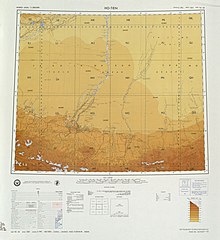Min-feng
Jump to navigation
Jump to search
See also: Minfeng
English
[edit]
Etymology
[edit]From the Wade–Giles romanization of the Mandarin 民豐/民丰 (Min²-feng¹).
Proper noun
[edit]Min-feng
- Alternative form of Minfeng (Niya)
- 1972 March 21, “CHINA”, in President's Daily Brief[1], CIA, page 3:
- Satellite photography suggests that the Chinese have plans to launch ICBMs from the Wu-chai launch complex to the Indian Ocean. Since late 1970, they have been building six permanent tracking sites near the Wu-chai rangehead, where they developed the CSS-2 IRBM. Recent photography shows that at least two of these sites are located well south of the CSS-2 flight path from Wu-chai to the regular impact area at Min-feng, some 1,400 nm to the west. In addition, work on a large silo has been under way at Wu-chai since the summer of 1968.
- 1974, William Watson, “T’ang Dynasty”, in Ancient China: The Discoveries of Post-Liberation Chinese Archaeology[2], New York Graphic Society, →ISBN, →LCCN, →OCLC, page 81, column 1:
- In the far west (Persia and the other countries of the Near East), the Chinese were held to be most remarkable for their figured silks. Fortunately the warm sand of such stations on the Silk Route as Turfan and Min-feng have preserved fragments of the weaves from which we can appreciate the artistry of colour and design as well as the barely credible skill of the weaving technique.
- 1975, Translations on People's Republic of China[3], United States Joint Publications Research Service, →OCLC, page 105:
- (b) Medium-speed type--Sand dunes whose average annual rate of forward movement is between 5 and 10 meters. Major regions include:[...]the region southwest of the Min-feng oasis, and Wa-shih-hsia, all in the Takla Makan Desert;[...]
- 1978, Translations on People's Republic of China[4], numbers 418-426, United States Joint Publications Research Service, →OCLC, page 41[5]:
- This year Min-feng County built a hydropower station by utilizing the water of "Water Way 818." Some brigades of Shang-you Commune, Mo-yu County built more than 10 small power plants by converting electric motors into generators. Lo-p'u County expanded its original hydropower capacity by adding on more generating sets; its generating capacity has greatly increased.
- 1998, Angela Sheng, “Innovations in Textile Techniques on China's Northwest Frontier, 500—700 AD”, in Asia Major[6], volume 11, number 2, Academia Sinica, page 121:
- The southern route, seemingly preferred by the Chinese, skirted the northern foothills of the Kunlun Mountains on the southern edge of the Tarim Basin. It, too, began at Tun-huang, with stops at Miran 米蘭 (in present-day Jo-chʻiang 若羌 county), Ni-ya 尼雅 (in present-day Min-feng 民豐 county), Khotan, Yarkand, and continued to Kashgar.
- For more quotations using this term, see Citations:Min-feng.
Translations
[edit]Minfeng — see Minfeng